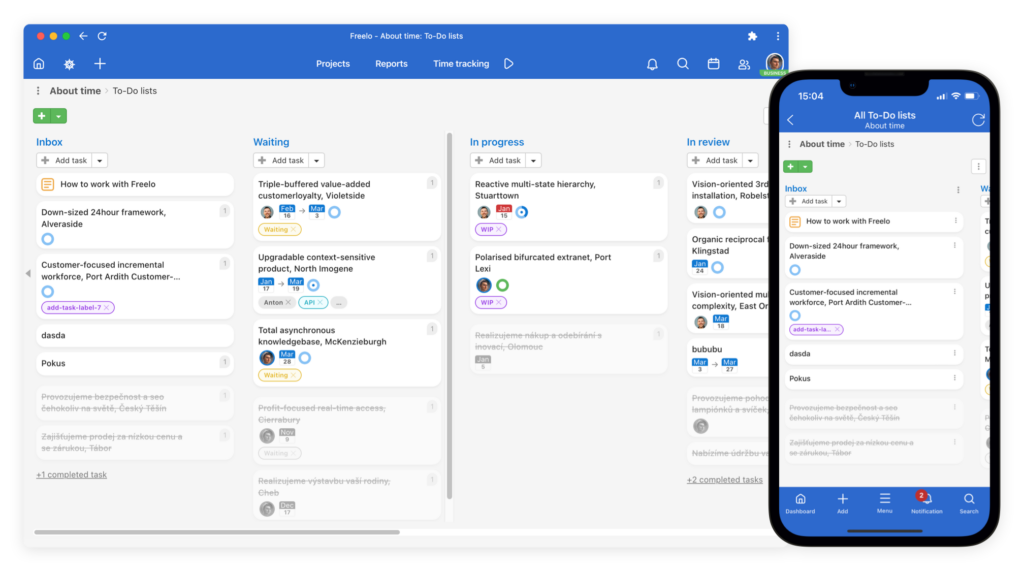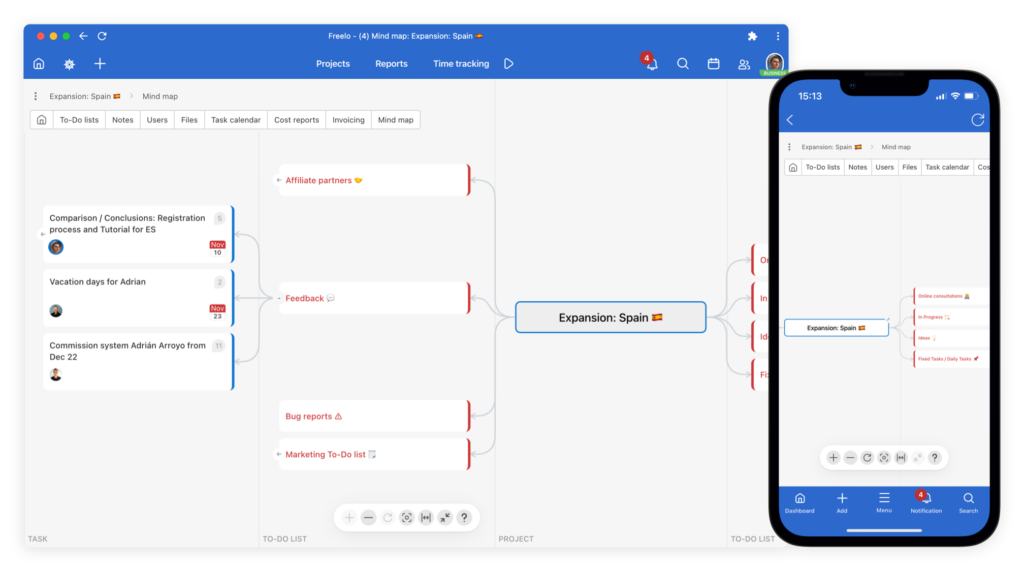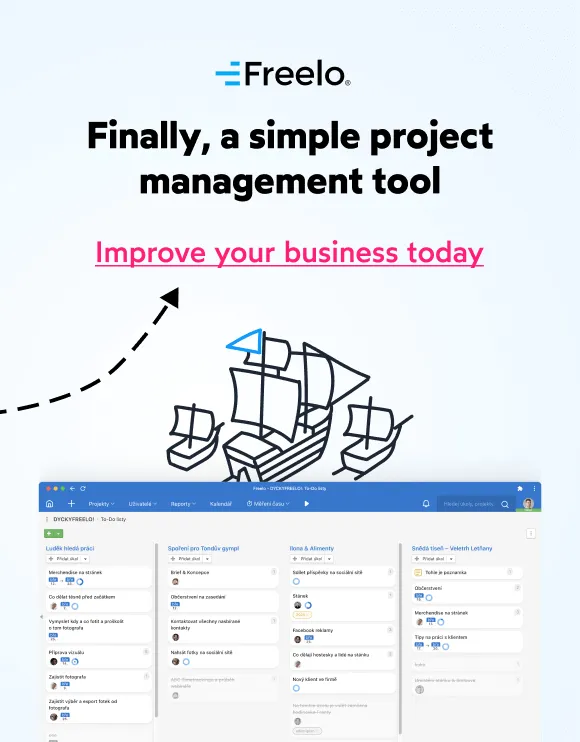
Everything about the Recruitment Process: Where to Find Employees
 Freelo team
Freelo team

Mid-2023 brings optimism to the labor market. Companies plan to replenish staff after freezing tenders at the end of the previous year amid fears of a looming crisis. This means a renewed shift of power towards candidates who feel „they can choose“. Recruiting for a slightly more difficult position costs the company around CZK 300,000 (according to flow-r), so the motivation to get through the selection process as quickly as possible and especially the first time is huge.
In this article you will get:
- Inspiration on where and how to finally find the long sought-after employee.
- New tips on how to impress candidates and how not to mess up during the selection process.
- Practical examples of how to effectively manage the processes around recruitment, from role definition to onboarding.
Recruitment from start to finish
Recruitment, as part of human resource management, is ongoing. Sometimes the search is intensive and other times we just collect contacts that come up on their own and maintain the reputation of the company. Active search can be divided into 7 steps.
-
Role definition
First, be clear about what the unicorn you’re looking for should look like. 🦄
Employer’s needs
- What are the responsibilities and competencies of the person in the position.
- What is the budget allocated to the position.
- What’s the name of the position.
Freelo Tip 👍
Excessive creativity in position names is harmful. Do you want the position to be tracked down and applied to by the right people? Then use established terms.
It’s not easy with job titles, e.g., Marketing Manager in a corporation means 7+ years in marketing, with at least a year’s experience in sales, team management and marketing research. However, in a smaller company or start-up, you may not have any of these requirements. Maybe what you envision doesn’t even have an established title. Therefore, also write specific ideas of what the person should have done.
Skills, knowledge alias „skill set“
Be clear about what your person needs to know and what is a „nice to have“, or not a requirement. Consider the juniority/seniority of the person according to your budget, but also according to the responsibilities they have to take on and the support you can give them.
Education
If education is not mandated by law, think about whether the candidate really needs it. Or whether it is necessary for the candidate to have a formal education (high school diploma, university degree) or whether it is sufficient that he/she has acquired the necessary knowledge and skills in other ways.
Character traits
Think about what character traits you expect from a successful candidate. Should he or she be more of an introvert, more detail-oriented, or a visionary? Character traits are the most important to look out for. These are hard to change.
-
Creating an ad: How to find employees
Posting an advertisement on a job portal is certainly not the only method of reaching potential job seekers. In any case, you will need a text that summarizes the job offer.
How to write an advert
Writing advertisements is usually in the job description of HR business partners or company owners who delegate it to HR generalists, back-office managers, etc. They are usually supervised by the hiring manager. For more complex positions, consider engaging a copywriter to make the job advert really catch the eye.
Give specific examples.
For example, the oft-cited flexibility means something different for everyone:
- I can work any time, any day, as long as the work is done.
- I can start between 8:00 and 9:00 a.m.
- I can’t do anything, but my boss will call me this weekend.
Avoid clichés.
Strike out phrases such as „dynamically developing company“ or „young team“. The former says nothing at all. The latter smacks of age discrimination.
CV photo yes, or no?
Legally, you should not ask for a photo because you could be discriminating on the basis of appearance. On the other hand, many applicants will send you a photo because they believe that their CV will be more memorable with a photo. If you are interested in a candidate who doesn’t have a photo and you really need to know what they look like, look on social media or arrange a short call with a camera.
Discrimination once more
Watch out for phrasing like „We’re looking for mothers on maternity leave, retired women…“ or „Are you young and energetic?“ All are discriminatory phrases.
To state the salary or not?
This is not (yet) regulated by law, but recently it has become part of the culture of good HR to state the pay range, which is supposed to help equalize the gender pay gap. Not keeping the topic of money until the final offer can save time for both parties. At Freelo, we disclose the remuneration.
Where to post the ad: Where to look for employees
The appropriate placement depends on the position advertised and the budget you have. You must (almost always) pay to advertise jobs.
- General job portals such as Jobs.com or those with a special focus, e.g., Techloop.io.
👉 Complete overview of work platforms
- Professional media: professional print and online media have a careers section where you can buy advertising. For example, the medical journal Tempus Medicorum.
- Professional Facebook groups that you can search for your given location. Do not forget to check the rules of the group or directly with the administrator.
- Newsletters of industry groups.
- High school and college websites and newsletters.
- Social networking through sharing from existing employees.
In addition to posting ads, think about direct outreach, or headhunting. Today, this is often done via LinkedIn.
This applies especially to hard-to-fill positions. These are those that remain open for more than a month. They exist in almost all sectors, namely craftsmen, line managers for production, doctors, medical workers, and programmers. These people are generally not looking for work.
Other industries with a shortage of workers are currently tourism, hotel, and catering (in the USA you will find the umbrella term hospitality, in Europe Horeca).
A hospitality consultant's opinion 💭
„Several issues are currently intertwined in hospitality recruitment:
- After the 2008 recession, there was a need to quickly fill more positions for colleagues who had left the industry. Less experienced people were temporarily put in charge. A similar situation is occurring now, except that the industry has lost a sense of income security due to circumstances during the pandemic.
- Some hospitality workers have forgotten their work habits during the covid pandemic or have permanently established themselves in other industries.
- The upcoming generation is not very interested in working in hospitality, among other reasons, because the work requires frequent face-to-face communication and high resistance to stress, and most positions cannot be performed from a home office.
Therefore, it is extremely important that hotels motivate new workers and help them overcome the barriers that each generation brings. The combination with technology works great, in which, unlike their predecessors, the new generation is at home. To this end, to train the communication competencies of hotel staff, we collaborated to develop a hotel in virtual reality. We are thus able to train situations from hotel practice in a realistic environment.
Thanks to VR technology, training can be done remotely, which partly creates the possibility of working from home. In recruiting, this works as a sexy draw.“ Described Jiřina Jenčková, founder and owner of Perfect Hotel Concept s.r.o., who together with colleagues from ČVUT, ZČU and VŠH (now UCP) participated in the project of development and testing of the Virtual Hotel.

-
How to process incoming responses
Ideally, devise a way of collecting responses so that all your entries fall into one place. You don’t want any promising candidate to get left out. Not only will you lose them in this selection process, but if you don’t hear from them at all, they will logically neglect you in the future.
Freelo Tip👍
For us, the team inbox tool Missive has proven to be useful not only for the selection process. They get notifications there, from all the advertising portals, which the customer care specialist then assigns to the responsible people. The first thing we ask candidates to do is to fill out a questionnaire, so we have all the information about them in one place. For each candidate who passes this pre-screen, our HR will set up a task in Freelo. There, he or she can work with the hiring manager on the next steps, such as assigning tasks, inviting them for an interview, making an offer, etc.
Often in professional groups on Facebook, job advertisers get „annoyed“ that people reply to their messages or write comments like „more info pls“ or „sz“. It is understandable that people respond in a way that is common on that social network. If you want to avoid this, write clear instructions on how to apply for the position in the text of the advert. For example, „Send an email with the subject line Position_appointment to prace@zadavatel.cz and attach a 1 A4 CV.“ Whether the candidate follows this will be the first sieve.
-
Interview first, or develop an assignment
It is a tricky question to which there is no clear answer. „There are usually 3 situations in which the job sponsor resorts to a test assignment,“ explains HR Specialist, Olga Fajkusova.
- He needs to filter the people he will be in individual contact with. Typical for positions where the number of applicants greatly exceeds the number of jobs. Should be a smaller task to verify that the candidate even knows where they are applying.
- It tests real skill – usually called a test assignment. It can be before a face-to-face interview, but usually the assignment is preceded by at least a short phone call to check agreement on key competencies and factors such as start date, salary, etc.
- It tests the skills for a specific project – sometimes it is even larger in scope, e.g., an adept for a marketing director is asked to design a marketing strategy, an adept for a Montessori school guide to plan a day of teaching.
If you feel that you are not getting quality people to apply, one option is to see if you are discouraging them with a task that is too challenging. Even if you don’t give it outright, trust that the wording will get the word out.
Candidates may suspect that:
- You’re just faking the selection process and trying to steal ideas, or you want the job for free.
- You don’t value candidates‘ free time and you won’t value employees‘ free time either.
- You don’t realize the difficulty of the task, so you won’t be a good boss.
I personally don’t like to give assignments until the candidate has seen someone from the company. We have a slightly different selection process for each position, but most often we give an assignment after the first round where the candidate has seen both HR and the hiring manager (we go together),
shares the experience of Silvie Kaderka, People Business Partner at Bonami.
Freelo Tip👍
As a first task, job seekers fill out an interactive questionnaire in which we also introduce the captains and the company culture. We are primarily concerned with whether the person would fit into the team, i.e. we check the cultural fit.
-
How to organize interviews
There are several ways to select a suitable candidate. Most often, contact with a candidate during the admissions process consists of the following stages:
- Prescreening: a telephone or online video call to quickly determine if the basic criteria are met.
- Written test: some positions require a test of, for example, logical thinking.
- 1st round interview: sometimes only with HR, sometimes with the hiring manager.
- Round 2 interview: with the head of the department or the whole business.
Choose the appropriate type of interview for the position. The STAR behavioral interview method, where the candidate describes the situation-task-activity-result, is generally popular.
The meeting does not have to take place in the form of an interview, but also, for example, in the form of an assessment center, where candidates interact with each other and work out group and individual tasks on the spot. However, this is a relatively expensive and preparation-intensive option.
-
How to communicate with rejected tenderers
Although it is challenging and sometimes unrealistic, try to answer all applicants as a courtesy. They are potential customers and may recommend you as an employer to their friends. For those where you see at least some potential, make a special effort to say goodbye on a good note. Maybe they will work on themselves and become useful members of the team in the future.
Just be careful that you must not keep the personal data of the participants in the selection procedure (including their contact details) without their consent for longer than the end of the selected candidate’s probationary period. This is when your legitimate interest ends. With explicit consent, you can then keep personal data for longer (approximately 3 years).
Freelo Tip👍
Our HR manager Christine records feedback to all candidates who have completed the task via the Loom app (screen, voice and webcam recording). It takes almost as much time as an email, yet is more personal.
-
How to communicate with the selected tenderer: preboarding
Don’t underestimate communication so that your new colleague doesn’t change his mind in the dead space between interview, offer and start. For example, send materials about the company to study, include him in the company’s internal communication, give him a clear plan of what will happen during the first few days. This process is called preboarding.
Legal requirements for recruitment
As part of preboarding, you will deal with the vast majority of the legal obligations you have as an employer.
Entrance examination for employment
Mandatory medical examinations are not compulsory for all employees from 2023. This means that low-risk employees, especially in office-based professions, have less to worry about and employers save costs. The impact on occupational diseases should be minimal.
GDPR in recruitment
Previously, the first document a candidate signed was the employment contract. Nowadays, the first document is more likely to be a consent to data processing – a template. However, it does not necessarily have to be in paper form. It can also be replaced by a tick-box on the web.
Taxation of the recruitment allowance
The recruitment allowance is another lure for hard-to-fill positions. Often offered by employers to production workers, it is also encountered by doctors and nurses in less popular areas of the country.
For employers, the recruitment allowance is a tax-deductible expense. The employee is taxed on the contribution and pays health and social insurance on it. This is not the only reason why it is highly problematic to recover the recruitment allowance if the conditions of recruitment are not met. Therefore, think about the payment and make sure it is well contracted.
Paying recruitment or other incentive payments (e.g., for employee referrals) in medical or health vouchers for tax-free purposes is not correct from an accounting point of view. This is because the allowance is income received in connection with future employment and is therefore taxable, unlike medical vouchers under employee benefits.
Onboarding
The onboarding process is a special activity that takes place from the first day on the job until the end of the probationary period to try to integrate the new colleague as best as possible. Think of it as an adaptation phase, during which he or she learns how the different departments work, gets to know colleagues and becomes thoroughly familiar with the projects he or she will be working on. Quality onboarding contributes to lower employee turnover.

The most common onboarding methods
During onboarding, the most important role is played by the hiring manager, i.e., the supervisor who hired the new team member. However, teammates and HR are also involved. How specifically depends on the method chosen.
-
Buddy system
You will choose a more senior (and friendly) colleague who will help the newcomer with all the ins and outs of the new position. Ideally, take away from his/her normal workload so that he/she actually has time to devote to the newcomer. This method is advantageous for the newcomer in that they always know who to go to and don’t have to be so shy about asking questions.
-
Shadowing
In principle, it is very similar to the buddy system, but while the buddy works independently most of the time, during shadowing the new colleague is always behind the experienced colleague as a shadow. He or she looks under his or her hands and thus not only learns how to do the job, but also naturally adapts to the company culture.
-
Championship system
In a larger company, a new colleague is introduced to many departments, internal systems and processes that he or she has never encountered before because they are unique to the company. In such a case, it makes sense to assign employees so-called championships.
For example, Maruška is in charge of the ordering system, Eliška is in charge of the launch planning tool, Honza is in charge of the scorecard and Jana is in charge of graphics. The new employee will be given a list of all the topics to be familiarized with and will agree with the champion on the date and form of the „training“.
-
Work rotation
An increasingly popular method to help colleagues get a feel for how other departments do their work. The new colleague gets to experience working in all departments including, for example, production and the warehouse. This system is typical for internship or graduate positions, but it is not a requirement.
-
Training system
Proper adaptation cannot be done without education. Include a seminar on the company’s vision as well as training to introduce the newcomer to his first KPI.
Onboarding with Freelo
At Freelo, we have found it useful to have the whole onboarding in one project. Once a new sailor is selected, HR will create a project called Onboarding + sailor’s name. In cooperation with the hiring manager and the captain, he copies relevant information from the template there, such as:
- Introduction to the company culture and basic processes, the so-called FAQ for seafarers.
- Access to all the programs and tools he will need.
- Educational documents such as FAQs for customer support, notes for braids, etc.
- The first tasks he’ll be working on.
- 1:1 retrospective.

The advantage of templates in Freelo is that you can set default deadlines. For example, so that the start date is Day 0 and the initial medical examination should take place no later than D minus 10.
Don’t worry that it will take you a lot of time to create the template. If you already have the points written down somewhere, you can easily insert them into Freelo using a text file.
Nor is it necessary for every new employee to have access to Freelo. For example, tasks for positions in operations can be checked off by a manager who has a project as a checklist. His or her supervisor can look into the project at any time and check the onboarding status himself or herself.
If you want to inform an employee, for example, about the documents they need to bring on the day they start work, simply share the task with them via a public link.
How to transfer corporate know-how
There are countless options and something a little different will work in every company. Take a look at a few tips.
Google Docs
A simple method we use for longer texts full of images and links. We pin the links to the Freelo tasks to make them easier to find.
Templates
We couldn’t find anything better for repeated To-Do lists. If you read the template, you will become familiar with the process. And then you just copy it and start checking things off.
Mindmaps
A project with a mind map display of tasks also serves beautifully as a visualization of company processes. The individual tasks then serve as information pages.

Notes
Attach notes to projects or To-Do sheets explaining how to work with the project.
Feedback during onboarding
Regular feedback is important at all times, especially during the onboarding period. Use a recurring task to plan. During the probationary period, meet more than once a month.
👉 Read also:10 tips for effective feedback
Offboarding and outplacement
Offboarding is the sadder sibling of onboarding. Thorough templates hold you up even as you say goodbye to employees – taking away access and taking back the job aids you issued at onboarding. If the employee is leaving on good terms, perhaps to care for a family or retire, it’s obviously easier. If he or she is leaving involuntarily, arm yourself against negative emotions.
The bitter aftertaste of leaving is mitigated by outplacement, which is simply put, help with getting through a difficult period and finding a new job. This can include training, help with CV preparation, childcare, and a financial injection.
Why make the selection process as pleasant as possible for candidates
- You will support the performance of a suitable candidate.
Interviews are stressful for candidates and not everyone performs well under stress. Some resilience to stress is obviously desirable but consider how much you want to test it during the interview itself. Therefore, tailor the interview to the job. So that you don’t unnecessarily lose someone with quality expertise. For example, a programmer is not going to meet several new people face-to-face every day and present something to them in a coherent manner while on the job, so why would you want that in an interview.
- You’ll get a new customer.
If not now, maybe in the future. Therefore, treat the applicant with the same respect as you would treat your customers.
- You’ll spread good Word of Mouth.
Even if the candidate doesn’t become a new employee, they can still talk positively about you and attract new employees and customers.
Lucie, a marketeer, says: „I interviewed for an FMCG company, which has been my love brand for a long time. During the prescreening it became clear that the position and I were not a good match. Fortunately, everything was civil and dignified. It was obvious that they valued my time and theirs. Because of this, I was left with no negative feelings, I continue to shop there regularly and will gladly recommend friends to apply for the picker in the future.

What’s next?
- Catch that new employee and see how to reward him properly 👉An overview of employee compensation. What do employees really care about?
 Freelo team
Freelo team





